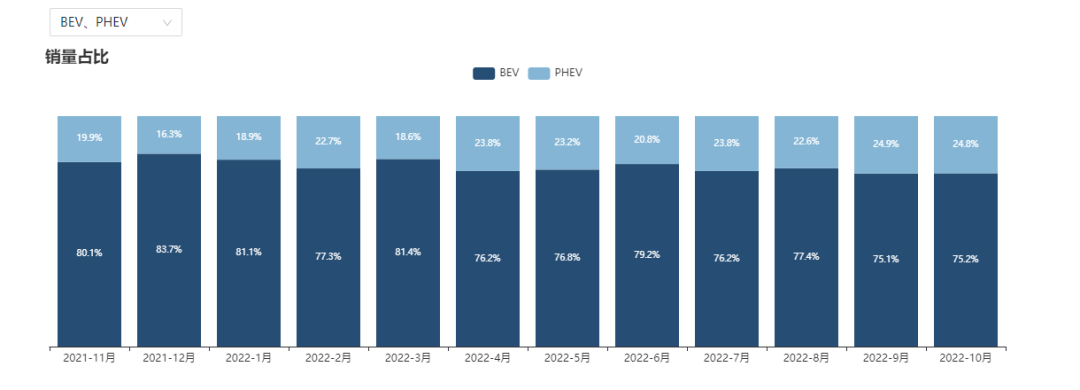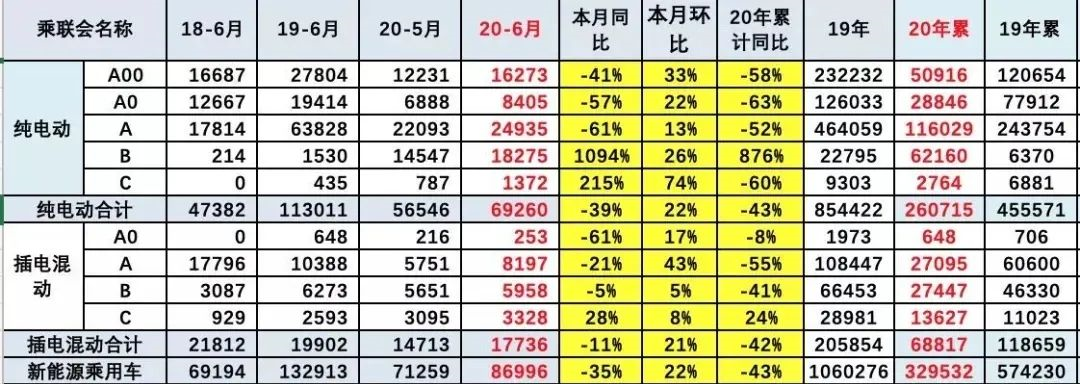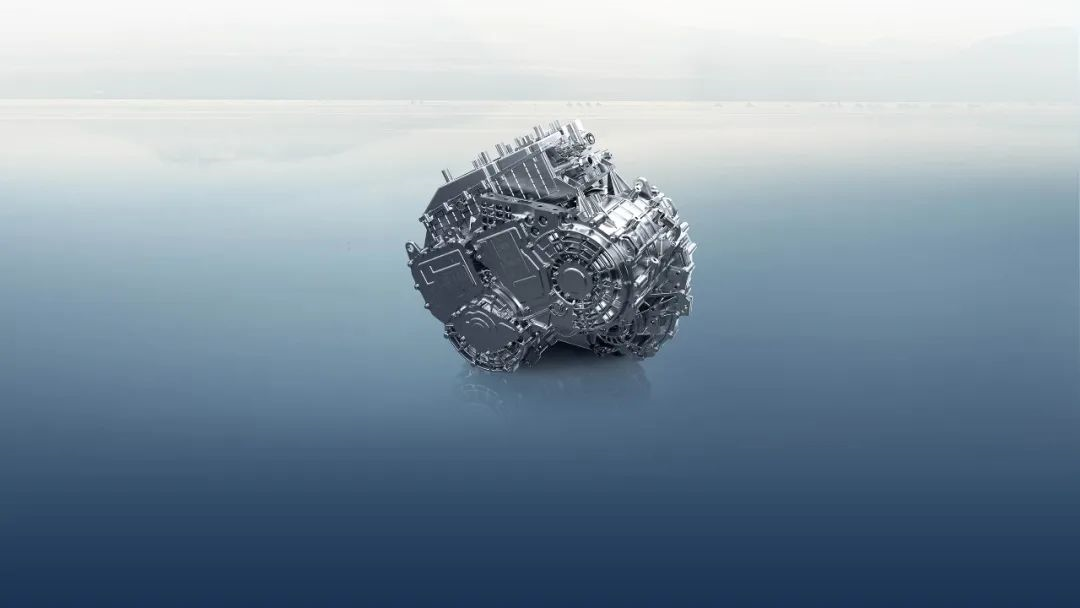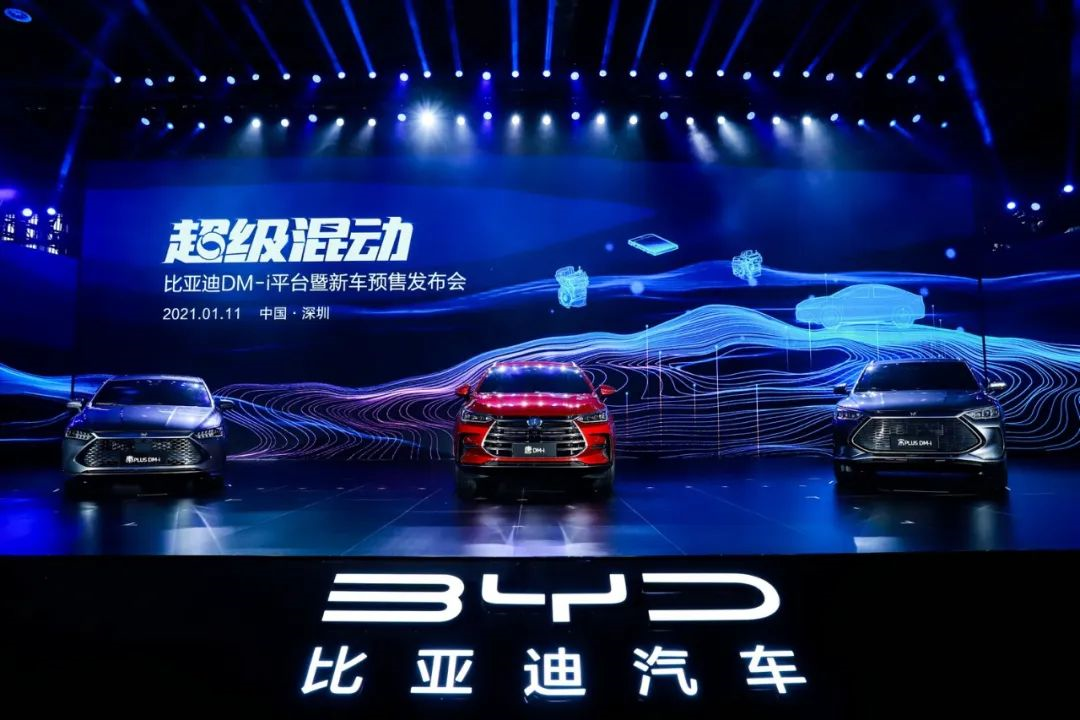Author: Wang Xuan
As a member of the automobile media, I am often asked by marketing personnel from various domestic car brands the same question: “Why is BYD’s hybrid product selling so well? What is the difference between our product and theirs? (Our products are also good, so why can’t we sell as much as they do?)”
Seemingly a simple question, it actually contains three layers of information: 1. Recognition of the potential of the plug-in hybrid market by car companies; 2. Anxiety about the performance of their own products in the market; 3. Curiosity about BYD’s success.
Plug-in hybrid, the only blue ocean market
Plug-in hybrids are one of the fastest-growing sub-markets in 2022. In January, the plug-in hybrid sub-market accounted for only 18.9% of the entire new energy vehicle market, but by October, it had grown to 24.8%, while the overall new energy vehicle market was also growing synchronously.

According to data from the China Association of Automobile Manufacturers, the new energy vehicle market in January-October 2022 grew nearly twice compared with the same period last year. In the past ten months, the average monthly market share of the plug-in hybrid market has reached 100-150 thousand units, and it is expected that the full-year sales of plug-in hybrid models will exceed 1 million units after the end of this year.

Hybrid models emerged around 2015. At that time, the head players in this market were represented by Japanese car companies such as Toyota and Honda. Unlike today’s plug-in hybrid technology, Japanese cars tended to use non-plug-in strong hybrid forms. Plug-in hybrids, on the other hand, are a technology born out of policies. Since 2010, the country has adopted subsidy policies to promote new energy vehicles. Compared with strong hybrid models, the advantage of plug-in hybrid models is that they can enjoy national subsidies.
On the other hand, at that time, domestic combustion engine technology was still not mature, and there was no sound supply chain system in the two core areas of batteries and motors. Therefore, it was difficult to imitate the hybrid technology of Japanese automakers. The fuel-saving point of plug-in hybrid technology comes from the ability to perform supplementary charging, rather than the logical and clear operating system formed by the complementation of motors and internal combustion engines.
The market development of plug-in hybrid technology has undergone twists and turns. Policies have stimulated the growth of this niche market, and while hybrid models have played a transitional role in the process of fuel vehicles transitioning to fully electric vehicles, nobody expected their lifecycle to be so short.
A turning point occurred in 2018 when new energy vehicle manufacturers entered the market like mushrooms after rain, and most of the products they launched were fully electric models. Under the premise that plug-in hybrid models had no core advantages over fuel vehicles, many users began to consider a one-step full electric option.
According to the data of the China Association of Automobile Manufacturers, the market penetration rate of new energy vehicles continued to rise from 2018 to 2020, but the market for plug-in hybrid models, which is a branch of new energy vehicles, has been continuously squeezed out by pure electric vehicles. In 2018, the total sales volume of plug-in hybrid models was 233,440 units, which dropped to 205,854 units in 2019, and the decline was even more pronounced in 2020.

In late 2020, things changed again, as independent brand automakers like BYD achieved breakthroughs in the fuel economy of plug-in hybrid technology, which gave it a significant boost in the market in 2021. As we enter 2022, high oil prices and lithium prices are forcing most consumers to reconsider plug-in hybrid models. Meanwhile, due to the rapid popularity of electric vehicles, issues such as grid pressure and bad charging piles are becoming a bottleneck for the growth of the fully-electric vehicle market.
In addition, plug-in hybrid models have the driving quality of a fully-electric car, and without the issue of range anxiety, it has been able to explode once again in 2022.
The plug-in hybrid market will be a new blue ocean for independent brand automakers. Judging from this year’s situation, plug-in hybrid models will continue to have a market share of millions of units in the next few years, and independent brands that bet on plug-in hybrid technology can also avoid competition from new energy vehicle manufacturers.
Currently, most new energy vehicle manufacturers are targeting the fully-electric domain. It is difficult for them to transition from fullyelectric vehicles to plug-in hybrids. Compared with fully-electric vehicles, plug-in hybrid technology has a higher threshold, which includes internal combustion engine efficiency, operating logic, and the matching degree of fuel engine and electric motor.## Anxiety is all in the PPT of hybrid technology
2022 is not only the outbreak year of the hybrid market, but also the year of the hybrid technology. If we count the fingertips, we will find that there are nearly ten types of hybrid technology on the market, including BYD DM-i, Great Wall DHT, Geely Emgrand, GAC Trumpchi, Chery Cowin Xingcheng iDD, Changan Blue Whale iDD, Dongfeng Mach, etc. And these car companies all want to participate in the competition for the million-level plug-in hybrid market.
Although the market is large enough, the actual situation now is that BYD dominates the market. Just this past October, the total sales volume of plug-in hybrid models was nearly 140,000, including 114,361 of BYD’s products, which means that this car company accounts for 80% of the market share.

Therefore, other independent brand market personnel asked, “Why can’t we outsell BYD?” The anxiety behind this reflects the fact that the market is growing, but only BYD enjoys the benefits.
From the perspective of technology and communication, we can also see the anxiety of car companies.
Presumably, many friends, like me, have recently locked their TVs on CCTV5 after work to follow the World Cup football matches. During the advertising time between matches, we saw an ad for the Haval H6 PHEV. Unlike the usual car ads, there were no celebrity endorsers and magnificent rivers and mountains. The main content of the ad was focused on the highlights of Great Wall DHT hybrid technology, such as “Dual-clutch DHT transmission” and “Hardshield battery pack”. Finally, it was mentioned that Haval is the “leader of new energy SUV.”
Professional technical vocabulary is rarely used in TV commercials, and it may be a bit obscure for the public. However, for car companies following behind BYD, they need to use some straightforward ways to prove the front-end nature of their technology.
The two most important features that users who choose plug-in hybrid products value are “better fuel economy and better driving quality”. It is also because car companies grasp the core needs of users that they will further expand their technology.
In fact, most of the independent brand’s hybrid technologies have the shadow of Honda i-MMD, and the closest one to it is BYD’s DM-i. On this basis, in order to further optimize fuel consumption performance and performance, some car companies choose to match the driving system with a two-gear transmission, such as the DHT of Great Wall.“`markdown

Meanwhile, car companies are also racking their brains to provide users with more diversified driving modes, such as Geely’s Thunderbolt hybrid system. In addition to matching the three-gear gearbox to further refine the operating range of the internal combustion engine, it also provides users with a series-parallel locking mode. Under all operating conditions, the engine and electric motor are in series, simulating the working logic of an extended-range electric vehicle, and allowing users to experience a completely pure electric vehicle-like driving experience on a plug-in hybrid.
markdown

Ultimately, whether optimizing fuel consumption or providing more driving mode options, it all comes down to using fresher technologies to create differentiated advantages.
However, the curve between hybrid technology and fuel economy and driving quality belongs to the first stage of rapid acceleration and the later stage tends to be stable. All fresh technologies can only improve as much as possible, but cannot cause a qualitative change, after all, physical bottlenecks are there. But the latecomers have to make such attempts, otherwise there is little possibility of a breakthrough.
Why is BYD Successful?
BYD’s success can be attributed to two points: 1. First-mover advantage. 2. High degree of vertical integration capability.
Currently, the most popular three car companies in the plug-in hybrid market are BYD, Geely, and Great Wall. We have also experienced their products. Frankly speaking, in fuel economy and driving quality, each of the companies’ products is on a relatively excellent level, but BYD’s first-mover advantage has indeed established its current market position.
We made a foreshadowing in the first subtitle. From 2018 to 2020, the plug-in hybrid market was squeezed by pure electric models, which was also BYD’s darkest hour. BYD’s first well-known plug-in hybrid model was the Tang DM launched in 2015, and since then BYD has never stopped exploring plug-in hybrid technology.
But they had a run of bad luck. In the rapid contraction of the plug-in hybrid market, many carmakers chose to transform, but BYD persisted. Of course, they also paid a heavy price for it. In early 2021, BYD handed in a monthly sales volume of 20,695, which was very poor for a carmaker with an extremely complete product line. Among them, the sales of new energy vehicle models were 10,123 (including plug-in hybrids and pure electric vehicle models), and more than half of the sales came from fuel vehicles.
“`
The turning point for BYD came in January 2021, when the company, which had long been dedicated to hybrid technology, introduced its new DM-i technology. The excellent fuel economy of the vehicle quickly won over its target audience. In May 2021, we visited a BYD 4S store and found that there was a shortage of supply with wait times for a DM-i model being in excess of five months.

Many people envy BYD for its sales volumes without realizing that BYD is actually the company that has opened up the plug-in hybrid market single-handedly. They should be gaining more attention from consumers in this field and be the dominant brand. In other words, “when choosing a plug-in hybrid, think BYD” has become a conditioned reflex for many consumers.
Moreover, the pandemic has also played a role in the growth of BYD. Against the background of supply chain disruptions, BYD has been able to maintain a self-consistent approach based on its self-developed technologies.
Recently, there was a piece of news that was not highly publicized, but it reflects many objective facts. German car rental company Sixt said it has signed a new cooperation agreement with Chinese automaker BYD and will purchase approximately 100,000 electric vehicles from BYD in the coming years.

Regarding this news, the director of the German Automotive Management Research Institute believes that Chinese companies have stronger delivery capabilities in the electric vehicle field than German car manufacturers. If you order a product from a European manufacturer, the delivery time will be over one year.
Self-developed technology ensures the core competitiveness of BYD’s products in terms of performance, while the supply can meet the increasing demand for products by consumers. These are the foundations that BYD has relied on in its pursuit of high-end markets.
Finally
Although BYD dominates the market, it is only a temporary phenomenon. As the plug-in hybrid market expands, more independent brands will have opportunities in this field. When the technology reaches a certain level, other car companies will catch up, and consumers’ demands for car models will become more diversified. At that time, it will be difficult for a single company like BYD to meet the demands of the vast majority of consumers. Car companies like Haval, which has been dedicated to the SUV market for years and whose car models have differentiated advantages, will gain more market share.# 这是一篇 Markdown 文章
我喜欢用 Markdown 编写文章,因为它简单易学,而且可以使用 HTML 标签。下面是一些示例:
-
加粗文本:使用
**文本**。 -
斜体文本:使用
*文本*。 -
加粗且斜体:使用
***文本***。 -
单行代码:使用 `代码`。 -
多行代码:
def print_hello(): print("Hello World!")
以上就是本文的内容了。
This is a Markdown Article
I like to write articles with Markdown, because it is easy to learn and allows using HTML tags. Here are some examples:
-
Bold text: Use
**text**. -
Italic text: Use
*text*. -
Bold and italic: Use
***text***. -
Inline code: Use `code`. -
Multiline code:
def print_hello(): print("Hello World!")
That’s all for this article.
This article is a translation by ChatGPT of a Chinese report from 42HOW. If you have any questions about it, please email bd@42how.com.
